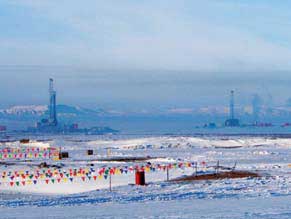EPA
Wasting No Time, Texas Rushes To Apply Health Care Ruling to EPA “Mandates”
 A huge national law firm that the State of Texas has hired to represent it in various facets of its anti-EPA jihad has taken the rhetoric of the recent Supreme Court decision and is now attempting to apply it to federal environmental mandates.
A huge national law firm that the State of Texas has hired to represent it in various facets of its anti-EPA jihad has taken the rhetoric of the recent Supreme Court decision and is now attempting to apply it to federal environmental mandates.
According to an Energy and Environment article from last week,
"The focus for now is on part of the health care decision in which the court held, on a 7-2 vote, that the federal government cannot take away all of a state's Medicaid funding if it declines to implement new provisions that were introduced under the reform law. The court saw such a move as akin to coercion.
Congress cannot "penalize states that choose not to participate in that new program by taking away their existing Medicaid funding," Chief Justice John Roberts wrote in the majority opinion.
Lawyers at the Baker Hostetler law firm, which represents Texas, were clearly paying attention to the academic debate that immediately broke out, in which some scholars saw similarities between the Medicaid provisions in the health care law and how the federal government interacts with states over their role in enforcing the Clean Air Act via state implementation plans, known as SIPs."
Most legal scholars don't believe this will go anywhere, but this move is just more evidence that Governor Perry and Co. are still fighting the Civil War all over again.
Dr. Al Breaks His Silence
 After over three months of not saying much about the circumstances of his resignation as EPA Region 6 Administrator, Dr. Al Armendariz used the online Texas Tribune for his coming-out this last week. He's joined the Sierra Club's Beyond Coal campaign as its southwest director.
After over three months of not saying much about the circumstances of his resignation as EPA Region 6 Administrator, Dr. Al Armendariz used the online Texas Tribune for his coming-out this last week. He's joined the Sierra Club's Beyond Coal campaign as its southwest director.
"I have a small handful of objectives. The first is to stop the construction of any new coal plants in Texas. And also to stop the expansion of any additional coal exports from Texas ports [to] overseas. The second objective is to work on the transition … to clean renewable sources of energy. And the third objective is to work really with all of the stakeholders in the state to further the development of renewable sources of energy, like wind and solar and geothermal."
Groups Sue Over Fracking Causing Rural Utah Smog Problem
 Last week five groups, including Utah Physicians for a Healthy Environment, EarthJustice, and the Southern Utah Wilderness Alliance sued the EPA for not classifying the Uintah Basin as a "non-attainment area" for the new federal ozone standard despite having plenty of evidence that the gas mining region is routinely experiencing some of the worst smog in the country.
Last week five groups, including Utah Physicians for a Healthy Environment, EarthJustice, and the Southern Utah Wilderness Alliance sued the EPA for not classifying the Uintah Basin as a "non-attainment area" for the new federal ozone standard despite having plenty of evidence that the gas mining region is routinely experiencing some of the worst smog in the country.
"It was once considered strictly a summertime problem in big cities. But winter pollution readings from the oil and gas fields of Wyoming and eastern Utah in the past seven years have shown the pollutants that create ozone— nitrogen oxides and volatile organic compounds — can also cause problems in snowy, rural areas.
Monitoring data in the Uintah Basin collected between 2009 and 2011 shows violations of federal health limits on ground-level ozone, which are set at 75 parts per billion. In 2010 and 2011, ozone levels rose as high as 121 parts per billion and 139 parts per billion, respectively."
To most of us this would mean the area is indeed due a non-attainment designation and should be required to draw up a plan to bring smog levels down. But to EPA, this only means the area is "unclassifiable," and it can put off that planning. That's why the groups are suing. And that's why it doesn't pay to think the EPA is taking care of everything.
But think about how this situation tests the claims of the gas industry operators.
In a previously pristine environment, without any cars or other kinds of heavy industry, they've now created smog on par with Los Angeles and Houston in the middle of extremely rural Utah…in the wintertime! They say they don't need new regulations; that they can voluntarily apply pollution controls. But in Utah, they either haven't done so in sufficient numbers, or those controls are clearly inadequate. Something more is needed than just voluntary controls.
Something like off-sets that require you to reduce as much air pollution as you spew.
Exposure to Phthalates (Plastics) Linked to Diabetes in Women
 Just last week we mentioned that one of the chemicals to look out for in burning plastics was phthalates – a class of widely-used chemicals that make plastic more plastic, i.e. more flexible. Phthalates are used in perfumes, cosmetics, and lots of household items made with Polyvinyl Chloride. This is how the stuff ends up in garbage, and how it can end up in your lungs when that garbage is burned at a cement kiln or power plant as "fuel" in the name of "recycling."
Just last week we mentioned that one of the chemicals to look out for in burning plastics was phthalates – a class of widely-used chemicals that make plastic more plastic, i.e. more flexible. Phthalates are used in perfumes, cosmetics, and lots of household items made with Polyvinyl Chloride. This is how the stuff ends up in garbage, and how it can end up in your lungs when that garbage is burned at a cement kiln or power plant as "fuel" in the name of "recycling."
This isn't a theoretical problem. When Midlothian area residents began collecting their own air samples downwind of the local hazardous-waste burning cement plants in the 1990's, they often found significant levels of phthalates.
From past research we know that exposure to phthalates in the womb can disrupt male hormones and have a range of health effects including feminizing male genitalia and reduced IQ.
And guess what? Ellis County rates of Hypospadias (a congenital birth defect in which the opening of the urethra is on the underside, rather than at the end, of the penis. are almost twice as high as for the state a a whole.
This week comes the news that Harvard scientists have linked phthalates to diabetes among women, and particularly to women of color in the Latino and Black communities who experienced the most exposure. Among these populations the risk of diabetes was double. The researchers cautioned that they don't yet know if phthalates actually cause the disease, but they seemed sure of an association.
“It’s extremely likely that phthalates and other chemical contaminants will turn out to be a big part of the obesity and diabetes epidemic, but at this point we really don't know how these chemicals are interacting with each other, or with the human body.”
Diabetes, an endocrine disease marked by problems with insulin production or insulin resistance, affects nearly 26 million Americans, or 11 percent of the population older than 20, according to CDC data. People of color already suffer disproportionally from the disease. According to the Centers for Disease Control, blacks have a diabetes rate 77 percent higher than that of whites, while Latinos have a 66 percent higher rate.
The Harvard study is at least the third in in two years to link phthalates to diabetes in women or adults in general.
“With phthalates, the story is really still emerging,” said Kristina Thayer, a researcher with the National Institute of Environmental Health Sciences and the National Toxicology Program. “Studies like these are considered exploratory, but they seem to be consistent.” “More needs to be done to really fill in this question of potential causality, and the roles that specific phthalates may play,” she added.
But don't expect the Chemical industry, EPA, or the Texas Commission on Environmental Quality to be concerned about this lack of information on the health effects of phthalates exposure. Don't expect them to postpone decisions about burning garbage for fuel because of these gaps in knowledge. Allowing things to happen without fully accounting for all of their hazards is just another day at the office for them. If you want these things to happen, you're going to have to Do-It-Yourself.
Groups Demand DFW Hearing on EPA’s Rollback of Cement Plant Rules
 In a letter sent Tuesday, ten grassroots and national groups from across the country, including Downwinders at Risk, joined together to call on EPA to schedule a public hearing in Dallas-Ft. Worth on its proposed rollback of cement plant emission rules.
In a letter sent Tuesday, ten grassroots and national groups from across the country, including Downwinders at Risk, joined together to call on EPA to schedule a public hearing in Dallas-Ft. Worth on its proposed rollback of cement plant emission rules.
In publishing the revised rules in the Federal Register last week, EPA proposed only one public hearing be held on August 2nd in North Carolina, where there is not a single operating cement plant, although the proposed new giant Titan cement plant is trying to win permit approval to operate near Cape Fear.
Downwinders was joined by Montanans Against Toxic Burning out of Bozeman; Montana Environmental Information Center in Helena; Selkirk, Coeymans, Ravena Against Pollution (SCRAP) in upstate New York; California Communities Against Toxics, based in Rosamond, the Stop Titan Action Network, Penderwatch and Conservancy, Cafe Fear River Watch, and North Carolina Coastal Federation, all from the Tarheel state, as well as Earthjustice, the DC-based legal defense team that has partnered with Downwinders and many of the other groups for 20 years in trying to get these new rules implemented.
In 2009, DFW was one of three metropolitan areas that hosted public hearings on the then-proposed rules, referred to as National Emission Standards for Hazardous Air Pollutants, or NESHAP. Over 200 people attended at the impossible-to-get-to DFW Airport Hotel and almost 100 testified – more than participated in the DC and LA hearings combined. All but five testified in favor of strong EPA regulation of cement plant emissions.
DFW is also downwind of the nation's largest concentration of cement plant manufacturing capacity, with three large plants and a total of six kilns operating today in Midlothian, in Ellis County.
EPA's changes to the rules, which include moving the compliance deadline from 2013 to 2015, as well as loosening the Particulate Matter standards and eliminating real time monitoring of PM pollution, were proposed just as the rules were about to be finalized and signed into law. No one at EPA can explain exactly why. No judge asked them to. The public didn't demand it. The Administration seems to be going out of its way to find favor with the cement industry even as the EPA is still carrying on a massive national enforcement initiative against it.
If you haven't done so already, please click here and send your comments opposing the changes in the cement plant emission rules. You only have until August 17th.
The full text of the groups' letter:
We, the undersigned groups, respectfully request that the Environmental Protection Agency hold a public hearing in Dallas, TX on its recently re-proposed NESHAP rule for Portland cement kilns. We request that this hearing be held in addition to the hearing scheduled at the Research Triangle Park facility in North Carolina.
There are no cement plants operating in North Carolina. It is incredibly important for the EPA to hold at least one public hearing in a location that is directly impacted by the toxic air pollution that this NESHAP rule addresses. Dallas is an appropriate additional hearing location for numerous reasons. First, there are multiple cement plants in the vicinity. Second, there is a precedent for public hearings on this rule in the region— on June 17, 2009, the EPA held a productive public hearing in Dallas on the Portland cement NESHAP. Third, Dallas's central location is more convenient for other impacted citizens from across the country who wish to travel to provide testimony.
We have worked for more than a decade to secure strong protections against the emissions of mercury, arsenic and other toxic air pollutants that cement plants emit. We would appreciate the opportunity to continue our involvement on this important issue at an additional public hearing in Dallas.
New Study: Reducing Smog Brings More Health Benefits
 In the same Washington Post article on the monkey business surrounding the new PM pollution standard comes news of a new study that concludes cutting smog pollution could bring added health care benefits that haven't been accurately estimated in the past.
In the same Washington Post article on the monkey business surrounding the new PM pollution standard comes news of a new study that concludes cutting smog pollution could bring added health care benefits that haven't been accurately estimated in the past.
Researchers at the University of California at Santa Barbara and MIT examined data for five years between 2003 and 2008 from the 20 Eastern states and the District of Columbia where power plants and boilers are required to limit nitrogen oxide pollution between May 1 and Sept. 30 each year – in other words, "oozne season."
During this time, they found prescription drug expenditures dropped by 1.9 percent, or $900 million a year, and the states and DC had 2,200 fewer annual premature deaths among individuals aged 75 or older.
“This is now new evidence of the evidence of the health benefits of ozone reductions, which was not available when the president overturned the previous effort to revise the ozone standard,” said MIT economist Michael Greenstone, who has informed White House officials of his findings.
“How your great grandmother’s chemical exposures may affect you”
 In a study published this week, "rats exposed in the womb to five common environmental pollutants passed on DNA-changing attributes that persisted in causing ovarian cancer three generation removed from the original exposure."
In a study published this week, "rats exposed in the womb to five common environmental pollutants passed on DNA-changing attributes that persisted in causing ovarian cancer three generation removed from the original exposure."
It's another example of "epigenetics" – when harmful environmental exposures to one generation can skip a generation or two and show up as health effects decades later.
According to the new study, the five pollutants reprogram how DNA is expressed in the developing fetus' eggs, setting the stage for ovarian disease later in their life.
If you're a Vet, the news is worse. The U.S. Department of Defense helped select the pollutants based on potential exposures in military personnel. They included vinclozolin, a fungicide that's used in the wine industry; a pesticide mixture including permethrin and DEET; a plastic mixture including bisphenol A (BPA) and two widely used phthalates (DEHP and DBP); the industrial byproduct dioxin; and a hydrocarbon mixture called "jet fuel," which is used to control dust on road surfaces.
Researchers at Washington State University exposed pregnant rats to one of five different chemicals alone or in mixtures during a critical time of pregnancy when their daughter pups' eggs were developing. The pups were then mated with males from the same treatment group, and the resulting pups were bred yet again. Only the original generation of pregnant rats had been exposed to the chemicals. The adult daughters and great granddaughters of the dosed animals (called the F1 and F3 generations) were examined for ovarian disease.
In all exposure groups, both the daughter (F1) and great-granddaughter (F3) mice had fewer egg follicles in their ovaries compared to controls, indicating a reduced pool of available eggs. Both generations – but particularly the F3 animals – also had an increased number of ovarian cysts compared to controls.These findings are characteristic of Polycystic Ovarian Syndrome (PCOS) and Premature Ovarian Insufficiency (POI), which are believed to affect 18% of all women.
Other diseases, including allergies and asthma; liver, gastric, prostate and colorectal cancer; and psychiatric disorders are thought to have an epigenetic component. This is the first time that epigenetic changes have been shown in association with ovarian disease. This proof-of-concept study used higher doses of chemicals than what people would typically encounter. Future work is needed to investigate whether lower, more environmentally relevant chemical levels also affect ovarian disease across generations of the rodents.
Locally, we're surrounded by sources of one or more of these pollutants, especially phthalates, BPA, dioxin, and hydrocarbons. BPA is the subject of a lot of media attention and just yesterday, the FDA banned its use in sippy cups for infants. Frisco's Exide lead smelter has been a top ten dioxin polluter in Texas over the last decade. The cement plants in Midlothian are also large industrial sources of dioxin, and new permits to burn more "non-hazardous" wastes that turn into hazardous emissions only ensure that will remain the case. On the ground, internal combustion engines from cars and the natural gas industry facilities in the Barnett Shale soak us in hydrocarbons.
Despite the documentation of the epigenetic effect of certain pollutants in recent years, this impact has not yet been incorporated into any risk assessment of a polluting facility by any environmental or public health agency in the U.S. We may be planting the seeds for epidemics of all kinds in the next 20-50 or more years, and it's all perfectly legal now. Once again, the science is way out in front of the regulations. That's why citizens must arm themselves with the latest research. You won't be getting updates on this stuff from EPA or TCEQ. That's also why it's ridiculous for anyone to speak about the "over-regulation" of polluters in this country. We're nowhere close to understanding what the long term consequences are of our actions in allowing so many chemicals into the environment to mix and match with our own biology. In this larger public health sense, pollution is still very much under-regulated in the United States.
Downwinders and Frisco Unleaded Send Notice: We’ll Enforce the Law if EPA Doesn’t
Our news release says it all:
Citing a lengthy list of unresolved federal violations, citizen groups tired of waiting for EPA to enforce the law at the Exide lead smelter in Frisco are gearing up to do it themselves.
Members of Frisco Unleaded and Downwinders at Risk gathered at 9:30 this morning in front of the Frisco Post Office on Stonebrook Parkway to mail "Notice of Intent" letters to Exide corporate representatives, EPA, and state environmental administrators. The action initiates the official 90-day notice required under federal law before the groups can step into the shoes of regulators and file a "Citizens Suit" to prosecute the smelter for violating the Clean Water Act, Clean Air Act, and the Resource and Conservation Recovery Act.
Although the smelter and the City of Frisco reached a settlement in May that required the 48-year old facility to cease active operations by the end of this year, there have been no fines or clean-up orders issued by either the EPA or the Texas Commission on Environmental Quality despite dozens of violations at the smelter dating back to 2009, including dumping lead waste into Stewart Creek, and burying hazardous waste without a permit.
"There are chronic contamination problems at Exide that still pose a hazard to Frisco residents and property. There's also a long history of law-breaking that the company must be held accountable for," said Colette McCadden, Secretary of Frisco Unleaded, "It's just unfortunate we have to file suit ourselves to make it happen."
In their 17-page Notice Letter the groups state they're acting now "to ensure that past environmental violations are addressed, and contamination at Exide's Plant is adequately and fully remediated to eliminate the substantial and imminent threat to public health and the environment resulting from such contamination," as well as, "to prevent future environmental violations and insure ongoing actions at Exide's Plant, including any clean up efforts, are conducted in such a way so as to prevent further contamination of the surrounding community."
There are 182 pages of attachments supporting the allegations made in the Notice Letter, including reports from both the EPA and TCEQ inspectors citing the smelter for numerous state and federal violations involving water quality, air quality, and handling and disposal of hazardous wastes.
"We're ecstatic that Exide will be closing its smelter," said Frisco Unleaded Co-Chair Meghan Green. "But as part of the settlement that makes that possible, the City of Frisco is leaving the fate of a Superfund-like site in the middle of our town up to Exide, EPA and TCEQ, – the same government agencies that allowed things to get so bad in the first place. Our lawsuit is the only way Frisco residents will have any guarantee that things will be done right this time."
In June, the TCEQ missed a deadline to submit a final clean air plan for the smelter before it closes, along with a chance to issue an enforcement order outlining what steps Exide must take to address long-standing violations uncovered by inspectors.
According to McCadden, "Frisco Unleaded and the Downwinders at Risk Education Fund view this lawsuit as an action of last resort after decades of regulatory failure concerning the Exide lead smelter."Frisco Unleaded is an affiliate of Downwinders at Risk that was founded only last August. Both groups are seen as instrumental in changing Frisco city policy from one of accommodation with the smelter last fall, to eventually pursuing a course of action to close it.Federal statutes require that groups that want to file Citizens Suits must give the targeted polluter and the appropriate agencies 90 days for the option of addressing the complaints outlined in a Notice Letter. That means that the groups can't officially file suit until at least October. Meanwhile, the EPA could act on its own or ignore the Letter."Up to now, the EPA has been alarmingly nonchalant about this outlaw smelter and the public health threat it represents," said Downwinders at Risk Director Jim Schermbeck. "We hope the agency will use our letter as a wake up call and finally enforce the law. We just want them to do their job."
Proposed Corpus Pet Coke Plant Too Dirty for New Power Plant Rules
 A $3 billion proposed power plant that would sit on Corpus Christi's bay and emit over 13 million tons of Greenhouse pollution a year may never be built because it can't meet new EPA power plant emissions rules. That's the headline of this Monday Fuel Fix article by the Houston Chronicle's Matthew Tresaugue.
A $3 billion proposed power plant that would sit on Corpus Christi's bay and emit over 13 million tons of Greenhouse pollution a year may never be built because it can't meet new EPA power plant emissions rules. That's the headline of this Monday Fuel Fix article by the Houston Chronicle's Matthew Tresaugue.
Chase Power was planning on opening the the Las Brisas (the Breezes) power plant in 2013, but that may never happen unless the company or the state of Texas is successful in lawsuits against the Agency's New Source Performance Standards.
Those standards don't apply to older plants, but they do apply to power plants under construction or planned, like Las Brisas. They require all power plants to achieve greenhouse emission limits that are difficult to meet without CO2 sequestration or other carbon-eating technology.
Las Brisias is designed to burn Petroleum Coke, a refinery by-product that is particularly nasty and releases as much carbon as coal. If it ever is built, it would instantly become the fourth largest CO2 polluter in the state.
Instead of trying to adapt or find a technology that could greatly reduce its carbon footprint, Chase Power is joining Texas in suing the EPA, while also petitioning to get an exemption from the Agency that would allow it to disregard the new greenhouse gas rules. Their local Congressman, Rep. Pete Olsen, is more than happy to oblige them.
Partners in Crime: TCEQ Lets Exide Lead Smelter Air Plan Deadline Pass
 Yeah, it's supposed to close by the end of the year. But that shouldn't mean the Exide lead smelter gets an even larger free pass to keep breaking the law on its way out the door.
Yeah, it's supposed to close by the end of the year. But that shouldn't mean the Exide lead smelter gets an even larger free pass to keep breaking the law on its way out the door.
Under the Clean Air Act, the facility is still subject to a clean-up plan for lead emissions that are violating the new federal lead-in-air standards passed in 2008. It's called a "State Implementation Plan," or SIP, because the state environmental agency, in this case the Texas Commission on Environmental Quality, is supposed to submit it to EPA for approval. The deadline for submitting Exide's SIP is July 1st, so the EPA has the required six months for public comment and processing through the Federal Register by the time the standard takes effect in December. As of today, the agenda for the last TCEQ Commissioners meeting in June did not have the Exide SIP on it.
It's true that the smelter doesn't have to start meeting that new standard until less than a month before it's scheduled closing via the agreement Exide and the City of Frisco announced in late May (and it's been exeeding that standard pretty regulalry since Spring began). But the adoption of a SIP could have put a nice regulatory bow on the package that the company and city have already prepared, and given the state the chance to tie up lots of loose enforcement ends.
By not submitting the SIP to EPA on time, the TCEQ is in violation of the law. What EPA will do about that is unknown, although its advocacy on behalf of Frisco residents over the long history of the smelter has been less than comprehensive and enthusiastic. Even now, neither it nor TCEQ have announced any fines or enforcement measures despite finding plenty of evidence of violations over the last three years' worth of inspections, much less the documented 30-year history of chronic abuses found in the agencies' files.
What might be some of the real world consequences of TCEQ lawbreaking this time? More lead air pollution and lead exposure to Frisco residents in the next six months than would otherwise have been allowed and more contamination of the land the City of Frisco has already bought and must pay to clean-up. A good thing to remember is how the company phased-out its Dixie Metals smelter in Dallas when it was forced to close by a December 31st 1990 deadline by the city. There was full production at the smelter until 12 Midnight, December 31st.
The official apathy of the state and federal agencies regarding Exide's criminal past and present has been breathtaking at times. So far, this missed SIP deadline seems to be one more yawnfest for them. Which is all the more reason citizens have to keep a vigilant eye on things even after the hoopla is over and the important work of cleaning-up a half-century's worth of poisons begins. Environmental protection is a do-it-yourself proposition.

